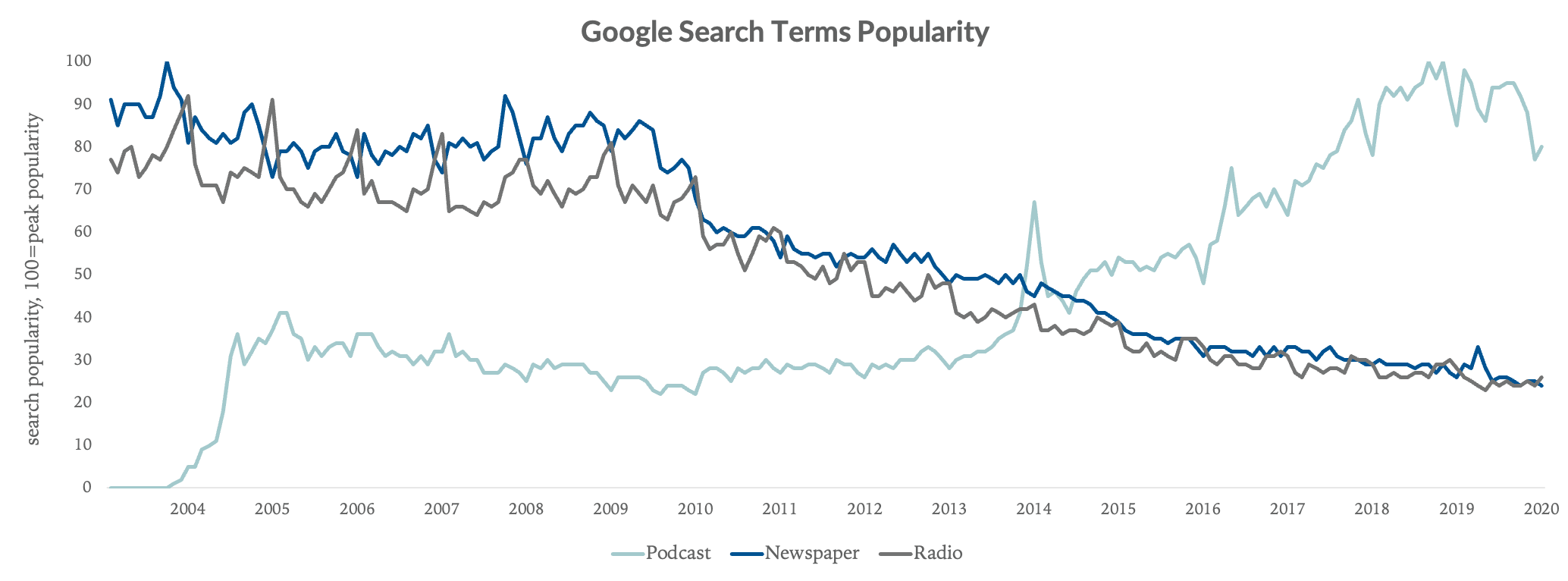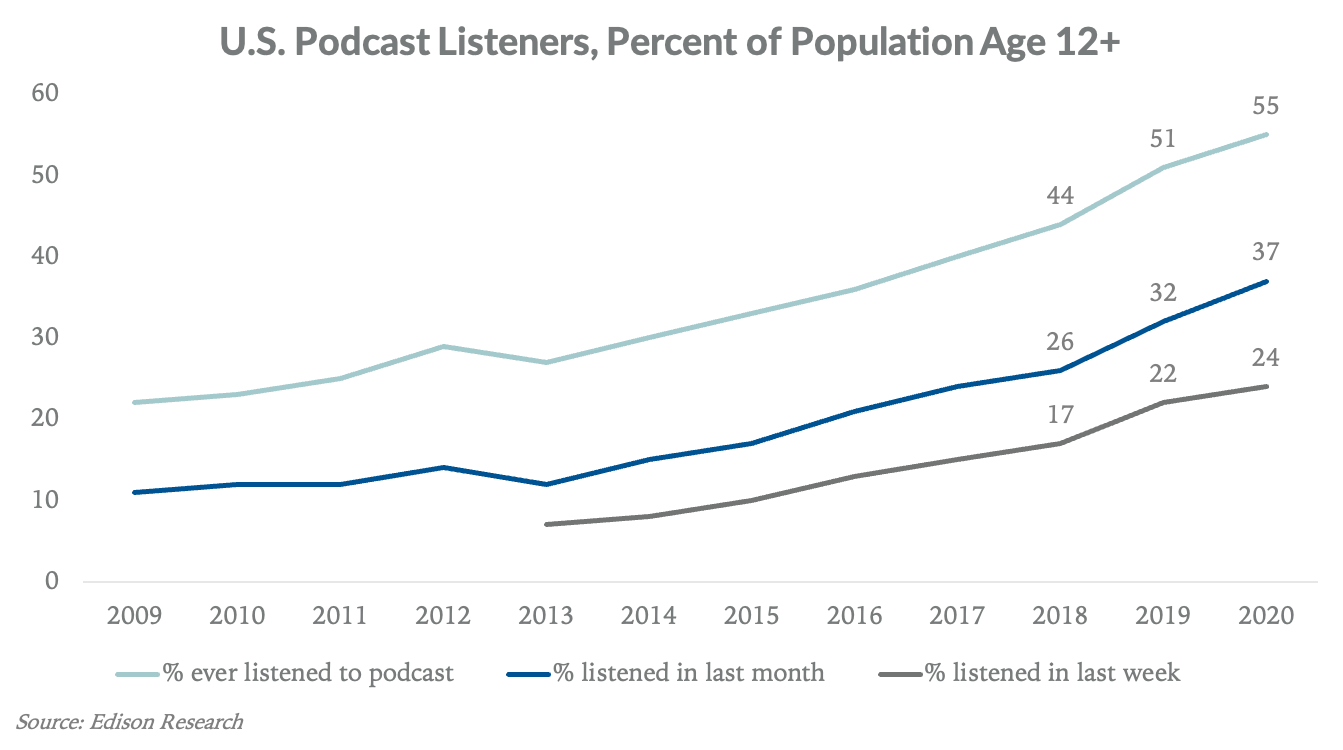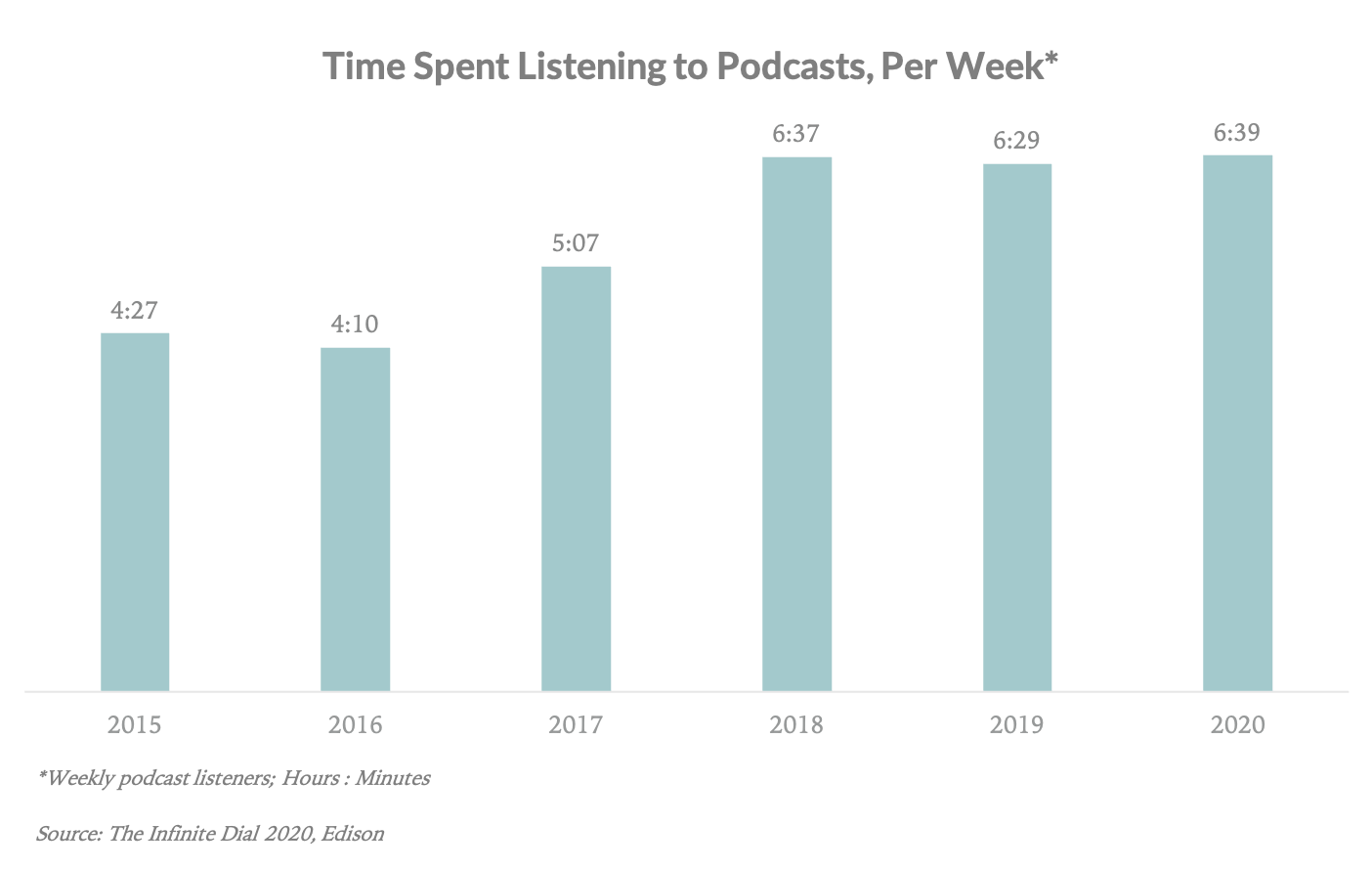The term podcasting, a combination of the word ‘iPod’ and ‘broadcasting’, is generally attributed to Ben Hammersley in an article written for the Guardian in 2004. Fun fact: in 2005, the New Oxford American Dictionary chose “Podcast” as the word of the year. Podcasting was born from a combination of the internet, free audio production and distribution software, along with portable music devices. Distribution platforms such as iTunes, which added podcasts in 2005, elevated podcasts to a wider audience.
Today podcasts have become an alternative to online print as well as books for learning, and video and radio for entertainment, allowing people to consume content in condensed formats. Audio’s distinct advantage over written word and video is that it can be enjoyed while doing other activities, such as walking, working out, cleaning, or on a commute. In this way, audio serves as an augmented reality layer in ways other media formats cannot.
While Google search trends do not tell us usage metrics, they do show that search interest in “podcasts” is inversely correlated with interest in “newspapers” and “radio” over the past 16 years:

Podcasts popularity
Of the US population ages 12 and older, an estimated 102m (37%) are monthly podcast listeners, and about 68m (24%) are weekly listeners.

Weekly users spend roughly 6 hours and 40 minutes per week listening to podcasts. Although flat since 2018, this represents a 50% increase since 2015, when Edison Research began tracking weekly listener minutes.

While more people are consuming podcasts, they still comprise a small amount of total audio consumption. Edison’s most recent Share of Ear study found podcasts account for 6% of total audio consumption (total audio consumption includes AM/FM radio, SiriusXM, YouTube, TV Music channels and more), up from 3% in 2018 and 2% in 2014. Surprisingly, AM/FM radio still dominates the audio ecosystem, commanding 40% plus of all audio consumption time.
With the increase in podcast listeners there has been rapid growth in the number of podcast shows on platforms such as Apple and Spotify. Active shows hosted on Apple Podcasts has increased from about 400k in 2017 to roughly 1m in 2021, a compound average growth rate of 25%.
Podcasts are Undermonitized
Podcasts are monetized primarily through advertisements today. US podcast revenue has grown from $480m in 2018 to over $810m in 2020 according to the Interactive Advertising Bureau. To put these numbers in perspective, annual podcast ad revenue is less than 5% the size of radio ad revenue and about 1.5% of TV advertising. However, the daily average amount of time spent listening to podcasts is about 10% the amount of time spent listening to radio and about 5% the amount of time spent watching TV.
We expect podcast ad revenue to continue to grow as podcast ad marketplaces develop, along with better targeting, similar to Google’s and Facebook’s ad platforms. Spotify’s recent acquisition of Megaphone, a podcast advertiser and publisher, is aimed toward that end. Separately, as part of our 2021 predictions, we expect Apple will take a page from Spotify’s playbook and bundle premium podcasts (Podcasts+) with Apple Music and Apple One at no extra charge for paying subscribers. Good news for podcasters, who may see Apple as another avenue to monetize their listener base.
Imagining the future of podcasting
Despite increasing popularity, only 55% of the US population age 12 and up have ever listened to a podcast (see chart 2 above). This means the remaining 45% have yet to try a podcast, leading us to believe podcasts are still in the middle part of the technology adoption curve. The challenge ahead is to attract and retain first-time listeners. We envision podcasts improving in a few ways, which we believe will increase adoption and usage:
Better discovery
Podcast discovery differs from music discovery in that podcast episodes are 5x-30x the length of a song, which means the potential sunk cost is much higher for a podcast than a song. This raises the stakes for platforms to curate recommended podcasts that land with listeners. Per Edison Research, the number one way podcast listeners currently find new shows is by “searching the internet.” Drawing on how Pandora and Spotify pioneered curated music playlists, we see podcast discovery moving in a similar direction.
This curation piece is one reason why, despite seeming antiquated, AM/FM radio continues to be popular. Radio is frictionless: turn a dial and start listening, with the listener limited to a finite number of choices. We view Apple’s September 2020 acquisition of Scout FM, which creates radio-like stations for podcasts, as an effort to reduce discovery friction for listeners.
Better search and learnings
As podcasts increasingly become used as a learning medium, there are opportunities to provide better search functions within and across podcast shows. Patrick O’Shaughnessy’s recent work with Colossus is a good example. Users can search by podcast guest or topic across the entire archive of O’Shaughnessy’s Invest Like the Best and Founder’s Field Guide episodes. For example, searching for “value investing” returns a list of episodes that contain the topic. From there, users can quickly read the audio transcript or jump to the relevant starting point within a podcast.
In the future, we see other platforms such as Spotify and Apple incorporating similar search features within and across podcasts shows. Ultimately, we envision it catching up with and keeping pace with YouTube’s video search features.
Follow the signs
In the past year, we’ve seen the consolidation of content studios and advertising technology in the podcast space by Spotify, Apple, and Amazon, among others. While bets from major tech companies do not guarantee success, they are strong indications that podcasting will continue to grow its share of total audio consumption. In the end, removing friction in discovery and search will increase the value of podcasts for learning and entertainment, thereby improving monetization for content makers.
